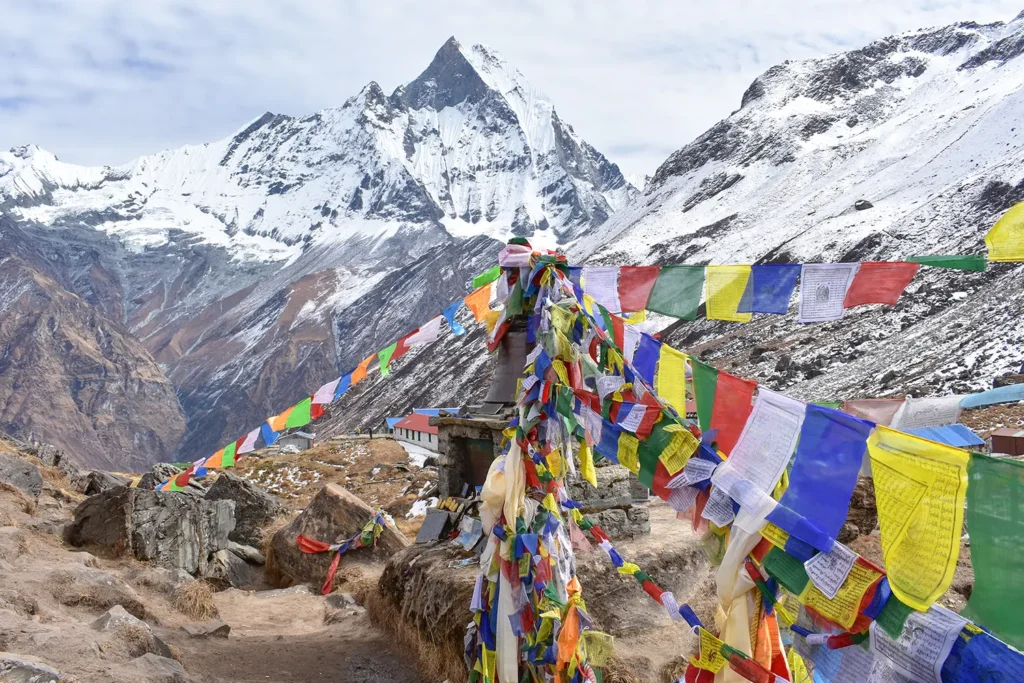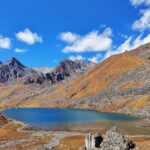Mount Everest in Nepal is the highest mountain in the world, towering at a staggering 8848 meters above sea level. While most people are familiar with the world’s highest peak, many may not know where the other nine highest mountains are located. Nepal, a landlocked country in the Himalayas, is home to eight of the world’s highest mountain peaks. Nepal shares four of these eight peaks with China, and one with India.
Mount Everest, known as Sagarmatha in Nepal, receives the maximum attention, courtesy of numerous movies and documentaries about the world’s highest peak. However, the other nine peaks also soar to altitudes above 8,000 meters. Climbers worldwide flock to Everest every season to experience being on top of the world. The other mountains are equally stunning, with some having higher casualty rates than Everest.
So delve and learn more about which is the tallest mountain in the world so that we are well aware of the Himalayan wonder beyond the glorious Everest.
Top 10 Highest Mountains in the World
| Name | Altitude | Location |
| Mt. Everest | 8,848m | Nepal, China |
| K2 | 8,611m | Pakistan, China |
| Kanchenjunga | 8,586m | India, Nepal |
| Lhotse | 8,516m | Nepal, Tibet Autonomous Region, China |
| Makalu | 8,485m | Nepal, Tibet Autonomous Region, China |
| Cho Oyu | 8,188m | Nepal, Tibet Autonomous Region, China |
| Dhaulagiri | 8,167m | Nepal, |
| Manasalu | 8,163m | Nepal |
| Nanga Parbat | 8,126m | Pakistan |
| Annapurna | 8,091m | Nepal |
Mount Everest – The highest mountain in the world
Do you know why the world’s highest mountain is named Everest? The tallest peak in the derives its name from the British Surveyor General of India, George Everest. It was known as Peak XV until Andrew Waugh, the surveyor general of India, proposed the mountain to be named after his predecessor, Sir George Everest.
The peak is also known as Sagarmatha in Nepal and Chomolungma in Tibet.
Mt Everest is located in the Himalayas on the Border between Nepal and Tibet. The peak was first summited by Sir Edmund Hillary and Tenzing Norgay in 1953.

The peak rises 8,848 mtrs above sea level. It is a dream of every climber who flies to Nepal hoping to conquer the highest peak in the world. Climbing Everest poses risks and challenges, but the allure of being on top of the world’s highest point remains irresistible, attracting hundreds of mountain climbers. These climbers test their mettle and luck during a brief climbing window between April – May.
Everest Base Camp Trek in Nepal takes you to the base of the world’s highest peak. You can climb to Kalapathar on the Everest Base Camp trek to soak in its magnificence and grandeur.
K2
K2 is the second-highest mountain in the world, rising to a staggering 8611 mtrs. The peak lies in the Karakoram Range on the border between Pakistan and China. K2 derives its name from the notation used by the Great Trigonometrical Survey of British India.
The second-highest peak in the world has a reputation for being the toughest mountain to conquer. Navigating the icy rock slopes of the peak has proved fatal to many climbers, registering the second-highest fatality rate per summit after Mt Annapurna. Climbing K2 demands strong technical climbing skills, exposing climbers to avalanches and rock falls. The fact that more than 6000 people have summited Everest as of November 2023, and approximately 700 have summited K2 as of August 2022 speaks volumes of how notorious K2 is. The mountain has rightly earned its nickname, “Savage Mountain” because of its steep, icy slopes and unpredictable weather conditions.
Kangchenjunga –
Kanchenjunga is located along the border between Nepal and the Indian State of Sikkim, Mt Kanchenjunga is the highest mountain peak in India. It is the third highest in the world, after Mt Everest. Considered a guardian deity by the Sikkimese people, the mountain is a symbol of cultural significance and reverence.
Kanchenjunga gets its name from four words of Tibetan origin, Kang-chen-dzo-nga. The mountain is known as the “Five Treasuries of the Great Snow.

The mighty Kanchenjunga allures people from around the world who wish to conquer its snowy slopes. While climbing the peak is restricted on Indian soil, Mt Kanchenjunga can be scaled from Nepal. Kanchenjunga is one of the least climbed mountain peaks after the indomitable Mt Annapurna, Nepal.
The locals consider it sacred and worship the peak as a mountain deity. Kanchenjunga is revered as Mayel Lyang by the indigenous peoples of Sikkim and as a Beyul (sacred hidden land) in Tibetan Buddhism.
To catch a glimpse of this breathtaking mountain, you can embark on the Sandakphu Trek and Goecha La Trek.
Lhotse – The ‘South Peak’
Lhotse is a less popular cousin of Everest. The name, Lhotse, translates to the ‘South Peak’ in Tibetan. The peak follows the same route as Everest until Lhotse Face and connects to Everest via the South Col. Fritz Luchsinger and Ernest Reiss ascended Lhotse, the fourth-highest peak in the world, in 1956.
Lhotse Massif has three summits with Lhotse I towering as the world’s fourth tallest peak. It lies on the border of Nepal and Tibet Autonomous Region, China.
While Everest grabs all the limelight, Lhotse positioned in the south of Everest is an equally enchanting mountain peak. This neighbouring peak of Everest presents a tough ascent for climbers who flock to the Himalayan country to scale the fourth-highest peak in the world.
Makalu
The fifth-highest mountain in the world rises to an elevation of 8,485 mtrs. Makalu stands in the Himalayas along the border between Nepal and the Tibet Autonomous Region in China. It has a distinctive pyramid shape and is known for its isolated position in the Everest massif.
The peak was summited for the first time by a French Expedition in May 1955. Jean Couzy and Lionel Terray ascended the Makalu summit, followed by seven more team members within two days. The attempt to ascend the steep glacier-covered sides began in 1954. It is considered one of the most challenging climbs due to its steep icy slopes and knife-edged ridges.
Cho Oyu
The sixth-highest mountain in the world is located in the Himalayas near the border of Nepal and TAR in China. It is the fourth eight-thousanders in the Everest region along with Makalu and Lhotse.
Due to its moderate slopes, the peak is considered one of the gentler and more achievable eight-thousanders to ascend. This makes Cho Oyu, a popular choice for climbers attempting to scale the first eight-thousanders.
Cho Oyu translates to “Turquoise Goddess” in Tibetan. The peak was first ascended in October 1954 via the northwest ridge by Herbert Tichy, Joseph Jöchler, and Sherpa Pasang Dawa Lama of an Austrian expedition.
Nangpa La, a glaciated Pass and a major trade route between Tibetans and Sherpas of the Khumbu region, lies a few km ahead of Cho Oyu.
Dhaulagiri
Dhaulagiri is the world’s seventh-highest mountain peak, located in Nepal. Towering at 8,167mtrs, Dhaulagiri I is the tallest peak of Dhaulagiri Massif. The peak lies on the western side of the world’s deepest gorge, the Kali Gandaki Gorge.
The name, Dhaulagiri, translates to White Mountain in Sanskrit and is a popular eight thousander for an expedition. This world’s 7th highest mountain in the world was ascended for the first time in May 1960. The peak mesmerises trekkers with its breathtaking visibility on the Annapurna Circuit Trek that traverses the Annapurna Conservation Area. You can glimpse Dhaulagiri from the lake town of Pokhara along with other peaks such as Annapurna, Manaslu, and Machapuchare.
Manaslu
Nepal is home to the world’s eighth-highest peak, Manaslu. The peak is also known as the Mountain of the Spirit. Both Nepalese and Tibetan Communities worship Mt Manaslu.
Manaslu is derived from the Sanskrit word, ‘Manasa’, meaning “intellect” or “soul”. The peak towers at a staggering 8,163 meters (26,781 feet). It was first scaled by a Japanese Expedition comprising, Toshio Imanishi and Gyalzen Norbu in May 1956.
Adventure enthusiasts can soak in the beauty of the world’s eighth-highest mountain from Manaslu Circuit Trek in Nepal.
Nanga Parbat – The ‘Naked Mountain’
Nanga Parbat, the ninth-highest mountain in the world, translates to “Naked Mountain” in Sanskrit, an intriguing name for a peak towering at an elevation of 8,126 mtrs. The peak has earned the name due to its snowless South face.
The mountain lies in the Gilgit Baltistan region in Pakistan Administered Kashmir and is locally known as Diamer or Deo Mir, meaning “huge mountain” in Tibetan. Nanga Parbat Peak stands out around the other low-lying valleys in the vicinity.
The ninth-highest mountain in the world has also earned itself a nickname, ‘Killer Mountain” owing to its high fatality rate and extremely difficult climb.
Annapurna
Annapurna is the tenth-highest mountain in the world located in Nepal. Rising to an elevation of 8,091 mtrs, Annapurna I is the tallest peak of the renowned Annapurna Massif. Though it is the tenth highest in the world, it is notorious for registering the highest fatality rate among the world’s highest peaks. The peak is known for its treacherous weather and high avalanche risk. While the peak is one of the most popular mountains in the world, Annapurna Base Camp Trek is a classic Himalayan experience that brings you face-to-face with Mt. Annapurna.

These are the highest mountains in the world, the Himalayan wonders! These towering summits are more than mere attractions for hundreds of climbers. These peaks represent nature’s meticulous creation.
Each mountain embodies the hope and dreams of hundreds of mountain climbers who dare to chase their aspirations, embarking on a challenging journey to conquer the peaks and be on the top of the world, literally and figuratively.





